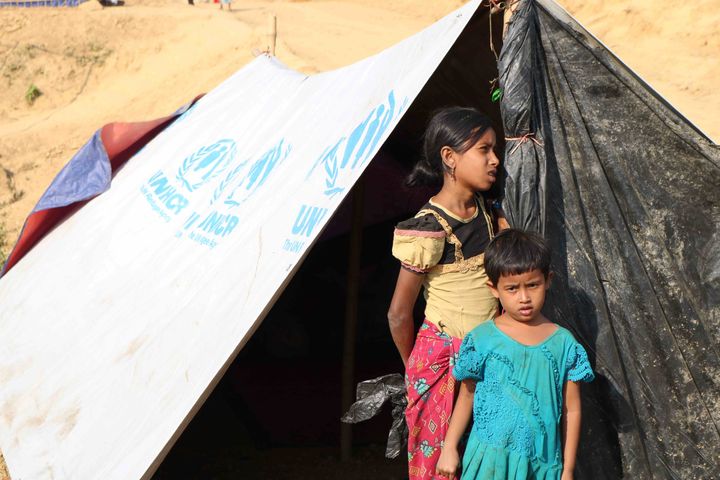
Rohingya children in the Kutupalong refugee camp, Bangladesh, November 2017.
It has been more than 69 years since the fledgling United Nations passed the Convention on the Prevention and Punishment of the Crime of Genocide. Now we have another genocide to add to the growing list of misery and terror since then: The Genocide of the Rohingya.
Prior to my trip to Bangladesh in November to interview Rohingya refugees, I suspected the Myanmar military’s violent campaign to expel the Muslim minority was part of an ongoing genocide. In response to the Buddhist government’s crackdown that has left 620,000 Rohingya people displaced since August and hundreds more dead, the United Nations had labeled these atrocities an “ethnic cleansing.”
UN human rights chief Zeid Ra'ad al-Hussein went a step further, saying genocide should not be ruled out. I commend his courage; the evidence and analysis he presented was entirely in line with what I witnessed. But not ruling it out does not go far enough. The genocide of the Rohingya is unfolding in plain sight on the world stage.
The week I spent with a filming crew in the Kutupalong refugee camp in Bangladesh, close to the Myanmar border, removed all doubt that the term “genocide” is applicable. Here I met damaged people bereft not only of their homes, which had been burned to the ground, but also in many cases their family members, who’d been murdered while fleeing villages under military siege.
There is a widespread misconception that genocide is all about the body count -- that the act cannot be labeled for what it is until tens or even hundreds of thousands of lives have been cut down.
But genocide is a process. That this one hasn’t yet reached that stage doesn’t make the actions less genocidal in intent.
The genocide of the Jews didn’t begin in 1941, when the Nazis started shooting them en mass. The process began in 1933, when Hitler came to power and instituted a boycott of Jewish-owned shops. Next came the systematic campaign of dehumanization: restrictions on travel and conducting business; citizenship laws which banned inter-marriage; ID cards depicting ethnic and religious identity; segregated schools; prohibitions on holding government positions.
Beginning in 1982, the government in Myanmar launched a similar campaign that now includes all of the above restrictions and more.
A leaked document – “The 1988 Rohingya Extermination Blueprint” – spells out the Myanmar government’s systematic, 11-point plan to shrink the Rohingya population by imposing “all possible methods of oppression and suppression against them.”
As in many genocidal campaigns, the latest in Myanmar is happening under cover of a pretext. On August 25, a group of Rohingya militants attacked a number of police outposts at a time when Myanmar security forces were intensifying their presence near Rohingya-occupied areas. A dozen Myanmar officers were killed.
This act, while reprehensible, does not justify the military’s scorched-earth response: houses burned, property looted, madrasas destroyed, deaths in every village, women raped.
In the refugee camps, we spoke at length to refugees who did not know one another, and yet their stories were chillingly similar.
The eight men we interviewed had between them seen 11 family members murdered, including children or siblings. Of the six women, three had lost their husbands to the violence; two had lost a child. Fourteen interviewees, 16 deaths.
But the similarities didn’t end there.
Accounts from the interviewees – who lived in villages across a wide region of the Rakhine State – suggest military orders from on high. This is a key attribute of state-sponsored genocidal activity.
These include:
• The persecution of religious leaders and the sexual assault of their wives
• Near-simultaneous campaigns by the military to burn villages
• Identical reports of military, police and local Buddhists cooperating on violent actions
• Stories of minors shot in the back as they fled
• Organized looting of valuables
The word “genocide” is a legal term. Adopted on Dec. 9, 1948 by the United Nations, it stipulates there be intent to destroy a group of a people “in whole or in part.”
To constitute a genocide, a violent campaign against a “national, ethnical, racial or religious group” need only commit one of five qualifying acts. The Myanmar authorities are already guilty of three:
• Killing members of a group
• Causing serious bodily or mental harm to members of the group
• Deliberately inflicting on the group conditions of life calculated to bring about its physical destruction in whole or in part
My fear is that the international community will fail to act, as there are too many world powers in the vicinity with skin in the game. That’s not to say I have no faith in the international community to do the right thing. But as someone who has spent a career working with victims of genocide, I can’t in good conscience wait for the verdict while so many suffer.
In the Kutupalong refugee camp, I came across a makeshift madrasa with hundreds of children who eat just one meal a day. I began to doubt myself. How can we think of filming interviews in this tableau of deprivation where such basic needs are going unmet?
But as it turned out, the Rohingya were desperate to tell their stories. They know that the world’s failure to understand the severity of their fate is partly what’s killing them.
